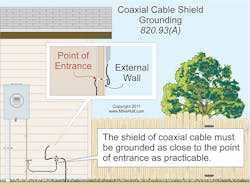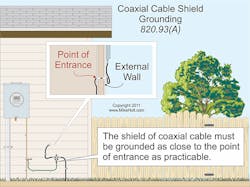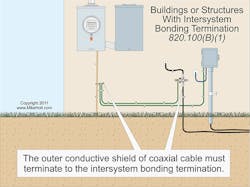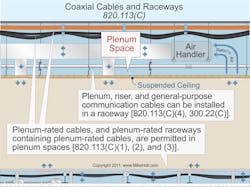While Art. 810 provides the requirements for transmission or reception via an antenna, Art. 820 provides the requirements for the distribution of television and radio signals within a facility or on a property via cable. These cable signals are limited energy, but they’re high frequency.
Coaxial cables that connect antennas to television and radio receiving equipment [810.3] and community television systems [810.4] must be installed per this section of the Code. Note: The NEC installation requirements don’t apply to communications utility equipment [90.2(B)(4)].
The requirements for CATV and radio distribution systems aren’t subject to the general requirements of Chapters 1 through 4 or the special requirements of Chapters 5 through 7, unless there’s a specific reference in Art. 820 to a rule in one of those chapters [90.3].
However, equipment must be installed per the manufacturer’s instructions [110.3(B)]. Optical fiber cable must be installed per Art. 770. Twisted-pair conductor cable used for communications circuits must comply with Art. 800. Cable routing assemblies must comply with the definition in 770.2, the applications in 770.154, and installation rules in 770.113.
Before you can correctly apply the requirements of Art. 820, you must determine the Point of Entrance (POE), which is the point within a building where the coaxial cable emerges from an external wall, from a concrete floor slab, or from a rigid metal conduit (RMC) or an intermediate metal conduit (IMC) connected per 820.100(B).
Mechanical execution
As with any installation involving communication cables installed above a suspending ceiling, you must locate these so that the suspended-ceiling panels can be moved to provide access to electrical equipment [820.21]. Install the cables in a neat and workmanlike manner [820.24]. Support exposed coaxial cables by the structural components of the building so the coaxial cable won’t be damaged by normal building use. Secure coaxial cables by straps, staples, cable ties, hangers, or similar fittings designed not to damage the coaxial cable [820.24]. Don’t use ceiling-support wires or the ceiling grid to support raceways or coaxial cables [300.11]. You can support these by independent support wires attached to the suspended ceiling in accordance with 300.11(A).
Coaxial cables installed through or parallel to framing members or furring strips must be protected where they’re likely to be penetrated by nails or screws. Provide this protection by installing the coaxial cables so they’re at least 1¼ in. from the nearest edge of the framing member or furring strips — or by protecting the coaxial cable with a 1⁄16-in.-thick steel plate or the equivalent [300.4(D)].
If a cable isn’t terminated at equipment or marked for future use, then it is an abandoned cable and must be removed [820.25 and 820.2].
Install the circuits and equipment in a way that doesn’t substantially increase the spread of fire or products of combustion [820.26]. Firestop electrical openings in fire-rated walls, floors, and ceilings.
Coaxial cables
You can use unlisted coaxial cable in building spaces (other than plenum), if the cable [820.48]:
• Isn’t longer than 50 ft from its point of entrance.
• Terminates at a grounding block.
Coaxial CATV cables entering the building or terminating on the outside must have the metallic sheath members grounded per 820.100 (see Fig. 1).
Grounding and bonding
For Articles 800, 810, and 820, the difference between a “bonding conductor” and a “GEC” is where they terminate. The bonding conductor terminates at the intersystem bonding termination. The GEC connects to the power grounding electrode system [250.50].
Coaxial cable confined within the premises and isolated from the outside cable plant can be grounded by a connection to an equipment grounding conductor. Connecting to an equipment grounding conductor through a grounded receptacle using a dedicated grounding conductor and permanently connected listed device is permitted. Use of a cord and plug for the connection to an equipment grounding conductor isn’t permitted.
For all other situations, the outer conductive shield of a coaxial cable must be bonded or grounded as follows [820.100].
The bonding conductor or grounding electrode conductor must be:
• Listed (insulated, covered, or bare).
• Copper or other corrosion-resistant conductive material (stranded or solid).
• At least 14 AWG with a current-carrying capacity of not less than the grounded metallic sheath member (or protected conductor of the communications cable); not required to be larger than 6 AWG.
• Run in as straight a line as practicable.
• Mechanically protected where subject to physical damage. Where installed in a metal raceway, each end of the raceway must be bonded to the bonding conductor or GEC.
• As short as practicable. For one- and two-family dwellings, the bonding conductor or GEC must not exceed
20 ft. If this limit isn’t practicable, install separate ground rod at least 8 ft long, with fittings suitable for the application [250.70 and 820.100(C)]; bond it to the power grounding electrode system with a minimum 6 AWG conductor [820.100(D)].
If the structure has an intersystem bonding termination, the bonding conductor or GEC must terminate to the intersystem bonding termination [250.94], as shown in Fig. 2.
If the structure has no intersystem bonding termination but does have a grounding means, then terminate the bonding conductor or GEC to the nearest accessible:
• Structure grounding electrode system [250.50].
• Interior metal water piping system, within 5 ft from its point of entrance [250.52(A)(1)].
• Accessible means external to the building, per 250.94 Exception.
• Nonflexible metallic service raceway of the power service.
• Service equipment enclosure.
• GEC or GEC metal enclosure.
• The bonding conductor or GEC or the grounding electrode of a remote building/structure disconnecting means [250.32].
If the structure has no intersystem bonding termination and no grounding means, terminate the bonding conductor or GEC to any individual grounding electrode described in:
• 250.52(A)(1), (A)(2), (A)(3), (A)(4), or
• 250.52(A)(5), 250.52(A)(6), and (A)(7).
Terminations to the grounding electrode must be by exothermic welding, listed lugs, listed pressure connectors, or clamps. Grounding fittings that are concrete-encased or buried in the earth must be listed for direct burial [250.70].
If a separate grounding electrode (e.g., ground rod) is installed for the CATV system, bond it to the building’s power grounding electrode system with a minimum 6 AWG conductor.
Indoor requirements
You can install coaxial cables in any Chapter 3 raceway [820.110]. You can also install them in listed communications raceways. If you use a listed communications nonmetallic raceway, follow 362.24 through 362.56. Note that raceway fill limitations of 300.17 don’t apply to coaxial cables.
If the length of the cable from its point of entrance exceeds 50 ft, the cable must be listed [820.113].
You can install CATV cables and raceways in plenum spaces if you use the cable types specified in 300.22(C), as shown in Fig. 3:
Coaxial cables can be in the same raceway, cable tray, cable routing assembly, or enclosure with conductors of any of the following [820.133]:
• Optical fiber cables per Parts I and IV of Art. 770.
• Coaxial cables per Parts I and IV of Art. 800.
• Class 2 and Class 3 circuits in compliance with Parts I and III of Art. 725.
• Power-limited fire alarm circuits per Parts I and III of Art. 760.
• Conductors of electric power and Class 1 circuits, where separated by a permanent barrier or listed divider.
• Power circuit conductors, if there only to provide power to coaxial cable system distribution equipment. The power circuit conductors must be separated at least ¼ in. from the coaxial cables.
Coaxial cables must maintain 2 in. of separation from electric power or Class 1 circuit conductors, unless they are:
• In a raceway.
• In metal-sheathed, metal-clad, nonmetallic-sheathed, or underground feeder cables [820.133], or
• Permanently separated by a continuous and firmly fixed nonconductor.
The same, but different
For all communications installations (Articles 800, 810, 820, 830, 840), you must determine the “point of entrance” for the circuits and ground the incoming cable as close as practicable to the point of entrance. Another common requirement is that cables run above ceilings can’t interfere with removing a ceiling panel for access.
What makes Art. 820 different from the others in this series is it applies to the distribution (to users) of the signals that come off the antenna systems that Art. 810 covers.
Holt is the owner of Mike Holt Enterprises, Inc. in Leesburg, Fla. He can be reached at www.mikeholt.com.
About the Author

Mike Holt
Mike Holt is the owner of Mike Holt Enterprises (www.MikeHolt.com), one of the largest electrical publishers in the United States. He earned a master's degree in the Business Administration Program (MBA) from the University of Miami. He earned his reputation as a National Electrical Code (NEC) expert by working his way up through the electrical trade. Formally a construction editor for two different trade publications, Mike started his career as an apprentice electrician and eventually became a master electrician, an electrical inspector, a contractor, and an educator. Mike has taught more than 1,000 classes on 30 different electrical-related subjects — ranging from alarm installations to exam preparation and voltage drop calculations. He continues to produce seminars, videos, books, and online training for the trade as well as contribute monthly Code content to EC&M magazine.



